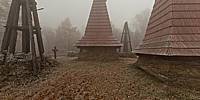
Cemetery No. 51 - Rotunda
51 Rotunda, Beskid Niski, Poland
November 13, 2011, 11:04 am
© 2011 Maciej G. Szling, All Rights Reserved.
Cmentarz założony był na planie koła, otoczony kamiennym murem szańcowym. Na teren cmentarza od wschodu, prowadziła drewniana bramka, w postaci gontowego daszku na słupach. Centralnie ustawionych było pięć wysokich, drewnianych wież krytych gontem, zakończonych drewnianymi krzyżami nakrytymi półokrągłymi daszkami, umocowanymi do ramion krzyża kulistymi czopami. Wieże posiadały wysmukłe gontowe dachy, łamane u podstawy, z małymi pulpitowymi okapami na 2/3 wysokości. Wieża centralna, stojąca w geometrycznym środku cmentarza miała wysokość około 16 m. Otaczały ją cztery niższe wieże, ustawione w kwadrat o współosiowych z wieżą centralną przekątnych. Dookoła znajdowało się 20 grobów pojedynczych oraz 4 mogiły zbiorowe. Na mogiłach stały proste drewniane krzyże belkowe, jedno i dwuramienne, z górnym ramieniem nakrytym małym deskowym daszkiem. Na skrzyżowaniu ramion umocowane były prostokątne drewniane tarcze o ściętych dolnych narożach. Spoczywają tam 42 żołnierze austro-węgierscy którzy należeli głównie do 1. Pułku Cesarskich Strzelców Tyrolskich, 36. Pułku Piechoty z Mlada Boleslav w Czechach, 59. Pułku Piechoty "Rainer" z Salzburga w Austrii, 1.Pułku Piechoty Landwehry z Wiednia, 25. Pułku Piechoty Landwehry. Spoczywa tam także 12 rosyjskich żołnierzy głównie z 193. Swijażskiego Pułku Piechoty.
Pierwotnie cmentarz, położony na szczycie nie zalesionej góry, był widoczny z daleka. Obecnie, tak jak okoliczne wzgórza, szczyt Rotundy porośnięty jest lasem. W 2002 i 2003 roku przeprowadzono prace porządkowe na terenie cmentarza, prace polegały na oczyszczaniu terenu z zarastającej go roślinności, karczowaniu pni drzew wyciętych kilka lat temu, oczyszczaniu kamiennego murka otaczającego cmentarz. Dzięki tym działaniom odsłonięty został zarys mogił oraz resztki kilku ocalałych krzyży.. Z drewnianych wież pozostały jedynie szkielety konstrukcji, a jedna z nich całkowicie się zawaliła. W miarę dobrym stanie pozostała chyba tylko kamienna tablica inskrypcyjna z wykutym krzyżem maltańskim i czterowierszem w języku niemieckim, autorstwa Hansa Hauptmanna. W tłumaczeniu brzmi on:
Nie płaczcie, że leżymy tak z dala od ludzi, A burze już nam nieraz we znaki się dały - Wszak słońce co dzień rano tu nas wcześniej budzi I wcześniej okrywa purpurą swej chwały.
Obiekt jest bardzo zniszczony. Szczyt góry oraz brak dobrych dróg zniechęca do podejmowania odbudowy. Cmentarz ten jako pierwszy po wojnie, w 1980 roku, został wpisany do rejestru zabytków, ale dotąd nie doczekał się żadnego remontu, czy choćby zabezpieczenia. W osiemdziesiątą rocznicę Operacji Gorlickiej powstała inicjatywa odbudowy cmentarza przy pomocy Austriackiego Czarnego Krzyża (społecznej organizacji opiekującej się grobami żołnierskimi). Niestety skończyło się na wycięciu drzew i krzewów wokół cmentarza, ponieważ na więcej nie starczyło funduszy. Jako obiekt drewniany cmentarz narażony jest na niszczący wpływ warunków atmosferycznych, a pozbawiony jakiejkolwiek opieki i konserwacji uległ całkowitemu niemal zniszczeniu. Zresztą cykl rujnowania cmentarza rozpoczęło już wojsko strzegące pogranicza tuż po zakończeniu II wojny światowej, lokując na najwyższej z wież, po zwaleniu krzyża, punkt obserwacyjny. Obecnie, to co z niego pozostało, kwalifikuje się tylko do rozbiórki i postawienia wszystkiego od nowa.
Google English translation:
In the western part of the Carpathian Mountains, between the valleys and Zdynia Regetówki, there is a wooded ridge of the Rotunda. At the top is a military cemetery No. 51, World War I, one of hundreds of such buildings erected in the years 1915-1918 in Galicia by the Austrian authorities. It is perhaps the most proven and most interesting of the group of 31 cemeteries designed by Slovak architect Dušan Jurkowicza in the so-called. żmigrodzkiego circle.
The cemetery was founded on a circle, surrounded by a stone wall szańcowym. To the cemetery from the east, ran a wooden gate, in a shingle roof on poles. The centrally positioned were five tall, wooden towers, covered with shingles, wooden crosses nakrytymi ended semicircular roofs, fixed to the arms of the cross trunnion ball. Towers had a slender shingled roofs, broken at the base, with small pulpitowymi eaves at 2 / 3 height. The central tower, standing at the geometrical center of the cemetery had a height of approximately 16 m. It was surrounded by four lower towers, arranged in concentric square central tower diagonals. Around the graves there were 20 individual and 4 collective graves. For graves have wooden crosses simple beam, and a wishbone, with the upper arm covered with a small cap shuttering. At the intersection of the arms were attached to rectangular wooden shields cut the bottom corners. Buried there 42 Austro-Hungarian soldiers who belonged mainly to the first Tyrolean Riflemen Regiment of the Imperial, 36 Infantry Regiment from Mlada Boleslav in the Czech Republic, 59 Infantry Regiment, "Rainer" of Salzburg in Austria, 1.Pułku Infantry Landwehr of Vienna, 25 Landwehr Infantry Regiment. There lies also 12 Russian soldiers mainly from the 193rd Swijażskiego Infantry Regiment.
Originally the cemetery, located on the top is not forested mountains, visible from afar. Now, as the surrounding hills, the summit is covered with forest Rotunda. In 2002 and 2003 were carried out cleaning works at the cemetery, the work consisted of clearing the area of overgrown vegetation him, grubbing tree trunks cut a few years ago, the purification of coal Murka surrounding the cemetery. Thanks to these measures was unveiled an outline of the graves and remains of several survivors of crosses .. The only remaining wooden towers frameworks, and one of them collapsed completely. As good probably only remained a stone plaque with carved inscription Maltese cross and quatrains in German, by Hans Hauptmann. The translation reads it:
Do not cry, that lie so far away from the people, And sometimes we have thunderstorms in the characters to have given - After all the sun every morning wakes us here I've been covering his purple glory.
The object is destroyed. Top of the mountain and the lack of good roads as a disincentive to undertake reconstruction. This cemetery was the first after the war, in 1980, was entered in the register of monuments, but has not lived to see any repair, or even security. In the eightieth anniversary of Operation Gorlickie cemetery restoration initiative founded by the Austrian Black Cross (maintainer of social organization are the graves of soldiers). Unfortunately, I ended up cut trees and shrubs around the cemetery, because the more there was not enough funds. As the cemetery wooden object is exposed to the devastating impact of weather conditions, and without any care and maintenance was almost completely destroyed. Besides ruining the cemetery cycle has already started army guarding the border just after the Second World War, placing on top of the towers, after zwaleniu cross vantage point. Now, what's left of it, shall be eligible only for the demolition and putting everything from scratch.


 Tap or click the zoom icon in the bottom right corner of the picture to switch between in-page and fullscreen view
Tap or click the zoom icon in the bottom right corner of the picture to switch between in-page and fullscreen view